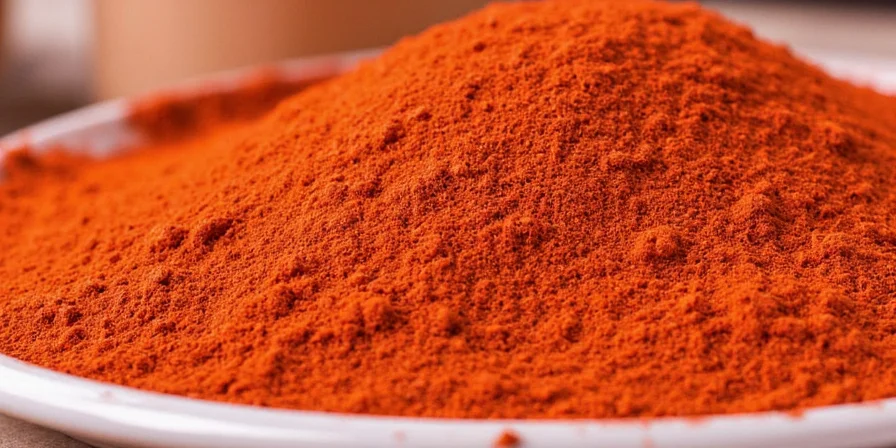Paprika transforms ordinary dishes into extraordinary ones when used correctly. For immediate results: bloom sweet paprika in oil at 300°F for 30 seconds to unlock flavor compounds, add smoked paprika late in cooking to preserve aroma, and store in opaque containers to maintain potency for 8 months. This guide solves paprika confusion with chef-tested techniques that work for home cooks.
Unlike generic spice guides, we deliver precise temperature controls, type-specific applications, and mistake prevention strategies backed by culinary science. Whether you're seasoning roasted vegetables or crafting global fusion dishes, these actionable methods deliver restaurant-quality results.
Table of Contents
- What Exactly is Paprika? (And Why Quality Matters)
- Sweet vs Smoked vs Hot Paprika: When to Use Each Type
- The Science Behind Paprika's Color and Flavor
- Global Paprika Applications Beyond Goulash and Paella
- 5 Professional Techniques for Perfect Paprika Usage
- 3 Costly Paprika Mistakes (And How to Fix Them Immediately)
- Why Paprika Deserves a Permanent Spot in Your Spice Rotation
What Exactly is Paprika? (And Why Quality Matters)
Paprika is ground from dried Capsicum annuum peppers, not seeds or fillers. True paprika contains only pepper flesh, creating its signature color from capsanthin (a heat-stable antioxidant). Hungarian and Spanish varieties dominate quality markets, with Hungary classifying paprika into eight grades based on ripeness and drying methods. Lower-quality blends often contain fillers like rice flour that dilute flavor and color impact.

Quality Indicator:
- Authentic paprika lists only "dried peppers" in ingredients, with no fillers
- Hungarian "Különleges" grade requires peppers ripened to exact sugar levels before sun-drying
Sweet vs Smoked vs Hot Paprika: When to Use Each Type
Selecting correctly prevents recipe disasters. This comparison solves paprika confusion:
| Type | Flavor Profile | Heat Level (Scoville) | Best Applications |
|---|---|---|---|
| Sweet Paprika | Mild pepper sweetness, no smoke | 0-100 SHU | Color-sensitive dishes (potato salad), deviled eggs, creamy sauces |
| Smoked Paprika (Pimentón) | Earthy oak-smoked depth | 100-1,000 SHU | Grilled meats, paella, BBQ rubs, roasted vegetables |
| Hot Paprika | Fruity heat with pepper notes | 1,000-10,000 SHU | Chorizo, bean stews, chili oils, marinades requiring heat |

Pro Selection Guide:
- For color without heat: Hungarian sweet paprika (look for "Édesnömör")
- For authentic Spanish flavor: Choose "Pimentón de la Vera" with PDO certification
- For heat control: Blend hot paprika with sweet (1:3 ratio) for balanced spice
The Science Behind Paprika's Color and Flavor
Capsanthin provides paprika's vibrant red without heat (unlike capsaicin in chilies). This carotenoid remains stable up to 325°F (163°C), making paprika ideal for color-sensitive dishes. Flavor compounds develop through:
- Aldehydes: Create sweet, bell pepper notes (dominant in sweet paprika)
- Ketones: Produce earthy undertones (enhanced in smoked varieties)
- Esters: Contribute fruity complexity (most prominent in hot paprika)

Critical Temperature Guide:
- Optimal bloom temperature: 300°F (150°C) for 30 seconds
- Burning threshold: 325°F (163°C) - causes bitterness
- Color preservation: Mix with acid (vinegar) before adding to alkaline dishes
Global Paprika Applications Beyond Goulash and Paella
Move beyond traditional uses with these chef-validated global techniques:
| Cuisine | Application | Proportion |
|---|---|---|
| Japanese | Sweet paprika in Kewpie mayo for tempura dip | 1/4 tsp per 1/4 cup mayo |
| Indian | Kashmiri paprika in butter chicken sauce | 1 tsp per serving (replaces cayenne) |
| Mexican | Smoked paprika in mole negro base | 1/2 tsp per cup sauce |
| Middle Eastern | Sweet paprika in hummus for color depth | 1/2 tsp per 2 cups chickpeas |

5 Professional Techniques for Perfect Paprika Usage
These field-tested methods solve common paprika problems:
- Bloom Properly: Heat oil to 300°F (150°C), remove from heat, then stir in paprika. This extracts flavor without burning.
- Layer Timing: Add sweet paprika early for base flavor, smoked paprika in last 5 minutes for aroma preservation.
- Acid Balance: Mix paprika with lemon juice or vinegar before adding to alkaline dishes (like potato salad) to prevent color fading.
- Heat Control: For color without heat, use sweet paprika; for heat without smoke, use hot paprika.
- Revive Stale Spices: Toast in dry skillet 60 seconds at low heat, then immediately cool to reactivate compounds.
Professional Paprika Oil Recipe
Yield: 1/4 cup | Shelf life: 2 weeks refrigerated
- 1/4 cup extra virgin olive oil
- 1 tsp sweet or smoked paprika
- Pinch of sea salt
Heat oil to 300°F, remove from heat, stir in paprika and salt. Cool completely before drizzling over roasted vegetables or fish. Strain for clear oil.
3 Costly Paprika Mistakes (And How to Fix Them Immediately)
Avoid these common errors with precision solutions:
| Mistake | Why It Happens | Instant Fix |
|---|---|---|
| Bitter paprika flavor | Burning above 325°F (163°C) | Bloom in oil below 300°F; never add to dry pans |
| Faded color in dishes | Alkaline environment (potatoes, eggs) | Mix with vinegar before adding (1:1 ratio) |
| Inconsistent heat levels | Misidentifying paprika types | Check labels for "dulce" (sweet), "ahumado" (smoked), "picante" (hot) |

Storage Protocol:
- Store in opaque container away from light and heat
- Refrigerate for 12-month freshness
- Freeze for 18-month potency retention (thaw before use)
Why Paprika Deserves a Permanent Spot in Your Spice Rotation
Paprika delivers disproportionate culinary value:
- ✅ Instant visual upgrade: Transform bland dishes with vibrant color (try on deviled eggs)
- ✅ Flavor amplifier: Enhance umami without salt (perfect for health-conscious cooking)
- ✅ Cross-cultural versatility: Works in 50+ global cuisines from Japanese to Mexican
- ✅ Cost-effective: $4 jar elevates meals for months (use 1/4 tsp per serving)
- ✅ Precision control: Select type for exact color/heat/smoke requirements












 浙公网安备
33010002000092号
浙公网安备
33010002000092号 浙B2-20120091-4
浙B2-20120091-4